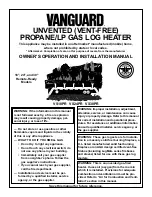
32
EKH-S, EWH, EKL, ES
Id. Nr.: 243701-5
The service water is emptied through the drain valve of the safety valve combination after closing the
shutoff valve in the cold water supply line and under simultaneous opening of all hot water valves of the
connected service fittings. Emptying may also be performed through the safety valve into the expansion
water funnel (drop collector). For this purpose, the small safety valve wheel is turned to the »Test« position.
Caution: hot water may exit during emptying.
In the case of a risk of frost, it must be observed also that not only the water in the water heater and in the
hot water lines can freeze, but also in all cold water supply lines to the service fittings and to the device
itself. Therefore, it is advisable to empty all fittings and lines holding water back to the frost-safe part of
the domestic water system (domestic water supply).
If the storage tank is put back into operation, then it must bindingly be observed that it is filled with water
and water exits bubble-free at the hot water valves.
INSPECTION, MAINTENANCE, SERVICE
a) During heating, the expansion water must drip visibly from the drain of the safety valve (the expansion
water drips from the valve of the mixing tap in the case of an unpressurised connection). The expansion
water quantity is approx. 3.5% of the tank’s rated volume when fully heated (approx. 80 °C).
The function of the safety valve must be checked regularly. The water must flow freely from the safety
valve unit into the drain funnel when the safety valve test knob is lifted or turned to the “Test” position.
Caution: the cold water supply and parts of the storage tank connector fittings may become hot there-
by.
If the water heater is not heated up or hot water is withdrawn, no water must drip from the safety valve.
If this is the case, then either the water line pressure is too high (install pressure reducing valve over 5.5
bar) or the safety valve defect. Please call a plumbing expert immediately!
b) The boiler scale as well as the furring forming in the internal boiler of the tank must be removed by an
expert after one to two years of operation in the case of heavily calciferous water.
Cleaning is performed through the flange opening. De-install heating flange, clean tank; a new seal
must be used in any case when the heating flange is mounted. The internal tank of the water heater
with special enamelling must not get in contact with boiler scale solvents – do not use an anti-liming
pump. Remove lime deposits with wood and aspirate or wipe out using a cloth.
Then rinse the device thoroughly (in accordance with ÖNORM H5195-1) and observe the heating pro-
cess in the same way as during first commissioning.
c) In order to ensure a corrosion protection and be entitled to any claims for warranty, as provided on the
side of the manufacturer, the installed magnesium anode requires checking by an expert at intervals of
max. 5 (Type EKH-S) or 2 (Types EWH, EKL) years of operation. The guard circuit shunt resistor below
the heating unit fastening screw must not be damaged or removed during maintenance works.
d) Do not use any abrasive cleaning agents and paint thinners (such as nitro, trichlor etc.) to clean the
device.
The best cleaning method is to use a damp cloth added with a few drops of a liquid household cleaner.
In hospitals and other public buildings, the prevailing regulations for cleaning and disinfection must be
observed.
During maintenance works, it is advisable to open the cleaning and service flange in order to check the
tank for any possible washing-in of foreign objects and contaminations, and to remove these if necessary.





































